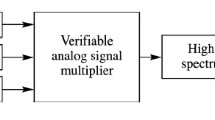Conclusions
It will be seen from this review of various methods for multiplying frequency that, in addition to the generally known multipliers which use functional conversion of the input signal, there can also be designed multiplying devices, based on level quantization, on shifting of signals with respect to their phase or time, and on balancing.
It should be noted that the output signal of the first group of multipliers has the same shape as their output signal. The frequency multiplication process in devices of the second and third groups can be accompanied by a transformation of the signal shape.
The application of a given type of multiplier in digital frequency-measuring instruments depends basically on the maximum permissible variation of the transducer's output frequency. Thus, in transducers with a small deviation it is, probably, advisable to use frequency multipliers of the first group. It is obvious that balancing multipliers whose comparison element consists of a reversible counter are predominantly suitable for transducers with a large frequency deviation.
The problem of obtaining the required frequency multiplier characteristics, consisting of their speed of operation and precision, requires a detailed investigation.
Similar content being viewed by others
Literature cited
M. E. Zhabotinskii and Yu. L. Sverdlov, Foundations of the Theory and Technology of Frequency Multiplication [in Russian], Izd. “Sovetskoe radio,” Moscow (1964).
A. Ya. Rotshtein, Author's Certificate No. 124004 (1958); Bulletin of Inventions No. 22 (1959).
A. G. Pinchuk, Author's Certificate No. 67166 (1946); Bulletin of Inventions No. 9 (1946).
A. K. Zavolokin and Yu. E. Rabkin, Author's Certificates Nos. 119718, 123243 (1958); Bulletins of Inventions Nos. 9 and 20 (1959).
G. A. Kondrashkova, Scientific Notes of Graduate Students and Candidates of the M. I. Kalinin Leningrad Polytechnic Institute (1964).
Mak-Alir, Zarubezhnaya radioélektronika (Foreign Radio Electronics), No. 4 (1960).
Burne and Goldstein, Bell Technical Journal,41, No. 2 (March, 1962).
Brooks, Electronics,32 (July 17, 1959).
V. G. Knorring, Izmerit. tekhn., No. 7 (1964).
Ya. V. Novosel'tsev, E. E. Afanas'ev, N. A. Smirnov, and E. P. Ugryumov, “Semiconductor frequency meter for nuclear-resonance magnetometers,” in the collection: Geophysical Instrument Making, 6th Issue [in Russian], Izd. “Nedra,” Leningrad (1960).
Additional information
Translated from Izmeritel'naya Tekhnika, No. 1, pp. 52–55, January, 1967.
Rights and permissions
About this article
Cite this article
Margolin, A.M. Design principles of frequency multipliers for digital frequency-measuring instruments. Meas Tech 10, 72–75 (1967). https://doi.org/10.1007/BF00979889
Received:
Issue Date:
DOI: https://doi.org/10.1007/BF00979889




